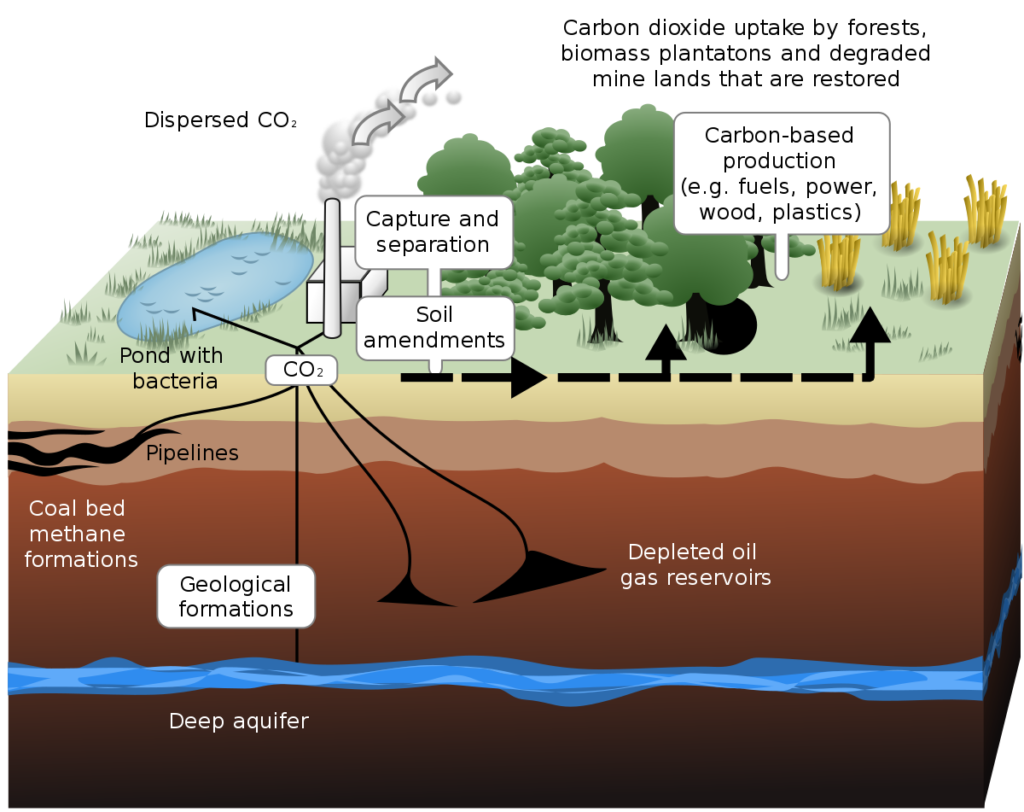Preventing the earth’s atmosphere from warming any further is taking a huge collective effort by humanity. From ending our dependency on carbon-emitting fuels to establishing a net zero emissions target by 2050, every potential solution is important if we’re to stop unprecedented climate change.
What is carbon sequestration?
Carbon sequestration is the capturing, removal and storage of carbon dioxide (CO2) from the earth’s atmosphere.
It is one method of reducing the amount of carbon dioxide in the atmosphere with the goal of reducing global climate change.

Why carbon sequestration is important?
This is important, as around 45% of the CO2 emitted by humans remains in the atmosphere, which is a significant factor behind global warming. Carbon sequestration can prevent further emissions from contributing to the heating of the planet.
How carbon sequestration can happen?
Carbon sequestration can happen in two basic forms: biologically or geologically. Also, while it’s being encouraged artificially through various biological and geological methods, it also happens naturally in the environment on the biggest scale.
What is biological carbon sequestration?
Biological carbon sequestration happens when carbon is stored in the natural environment. This includes what are known as ‘carbon sinks’, such as forests, grasslands, soil, oceans and other bodies of water. This is also known as an ‘indirect’ or passive form of sequestration.
How much carbon sequestration occurs through biological means?
Globally, the total amount of carbon in vegetation, soil, and detritus is roughly 2,200 gigatons (1 gigaton = 1 billion tons), and it is estimated that the amount of carbon sequestered annually by terrestrial ecosystems is approximately 2.6 gigatons.
The oceans themselves also accumulate carbon, and the amount found just under the surface is roughly 920 gigatons. The amount of carbon stored in the oceanic sink exceeds the amount in the atmosphere (about 760 gigatons).
Of the carbon emitted to the atmosphere by human activities, only 45 percent remains in the atmosphere; about 30 percent is taken up by the oceans, and the remainder is incorporated into terrestrial ecosystems.
Why forests and woodlands are considered one of the best forms of natural carbon sequestration?
Forests and woodlands are considered one of the best forms of natural carbon sequestration. CO2 binds to plants during photosynthesis, exchanging it for oxygen as a purifying emission.
On average, forests store twice as much carbon as they emit, while an estimated 25% of global carbon emissions are sequestered alongside forests in other vegetative forms, such as grasslands or rangelands (fields, prairies, shrublands etc.).
How soil acts as carbon sink?
Through bogs, peat and swamps, carbon can be captured and stored as carbonates. These carbonates build up over thousands of years as CO2 mixes with other mineral elements, such as calcium or magnesium.
Eventually, carbon is released from the earth, after more than 70,000 years in some cases.
How oceans acts as carbon sink?
Aquatic environments and large bodies of water are also great absorbers of CO2. They absorb estimated 25% of emitted CO2 from the earth’s atmosphere. This carbon is mostly held in the upper layers of the oceans.
Too much, however, can acidify the water, posing a threat to the biodiversity that exists below – yet another reason to decarbonise our atmosphere.
What is geological carbon sequestration?
Geologic carbon sequestration is the process of storing carbon dioxide (CO2) in underground geologic formations.
The CO2 is usually pressurized until it becomes a liquid, and then it is injected into porous rock formations in geologic basins.
This method of carbon storage is also sometimes a part of enhanced oil recovery, otherwise known as tertiary recovery, because it is typically used later in the life of a producing oil well. In enhanced oil recovery, the liquid CO2 is injected into the oil-bearing formation in order to reduce the viscosity of the oil and allow it to flow more easily to the oil well.

How graphene production results in carbon sequestration?
The production of graphene requires CO2 as a raw material. Although limited to certain industries, it’s used heavily in the production of the tech devices we use on a day-to-day basis, such as smartphones or computer processors.
What is Carbon Capture and Storage (CCS)?
CCS is a geoengineering technique which involves capturing carbon dioxide that has been produced by power generation or industrial activity, such as cement or steel-making. This CO2 is then compressed and transported to deep underground suitable storage locations , where it’s injected into rock formations for permanent storage.
Suitable storage locations might include geologic formations such as deep saline formations (sedimentary rocks whose pore spaces are saturated with water containing high concentrations of dissolved salts), depleted oil and gas reservoirs, or the deep ocean.
Although CCS typically refers to the capture of carbon dioxide directly at the source of emission before it can be released into the atmosphere, it may also include techniques such as the use of scrubbing towers and “artificial trees” to remove carbon dioxide from the surrounding air.
How can carbon sequestration be scaled?
We’re growing closer to developing technology that will allow carbon sequestration to happen on a massive scale. If carbon can be captured during any activity that offsets emissions, it will help us become carbon neutral more quickly.
The simplest way to scaling carbon capture is by encouraging our natural environment to grow, while preserving what already exists. Reforesting, rewilding or the reclamation of agricultural land will allow carbon capture on the largest scales, as will removing pollutants from our seas, lakes and oceans.
